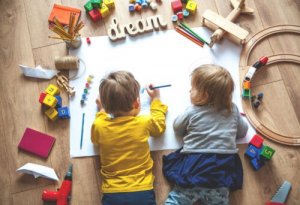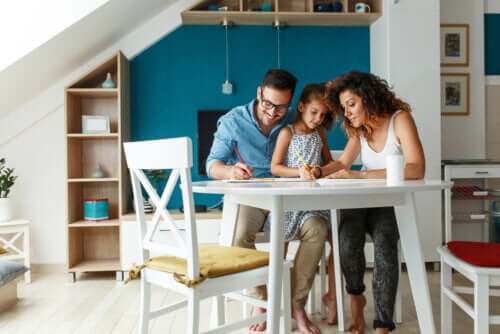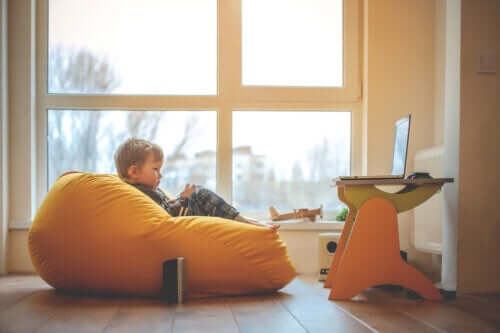How to Create a Children's Learning Space During Quarantine


Written and verified by the psychopedagogue María José Roldán
We’re not sure how long we’ll be at home with our children, nor when they’ll be able to go back to school. Confinement as a result of the COVID-19 crisis has us on tenterhooks on both a social and economic level. But, no matter when classes start back up again, it’s always a good idea to have a learning space at home.
It’s important to encourage creativity and learning not only in the classroom but at home as well. And not only during confinement, but any time when children need to do schoolwork at home. For example, over vacation or simply while doing daily assignments.
Creating a learning space for children
Creating a learning space for children in your home is an incredible way to allow your children to play and explore in the world around them. Building one may seem like a discouraging task at first. But setting up a comfortable and inspiring space for your children is easier than you think.

Make sure your learning space has plenty of light
If possible, try to find a place in your home that gets plenty of natural light throughout the day. Many studies have demonstrated the benefits of natural lighting in learning environments. For example, increased performance, well-being, and creativity. The more natural light you have, the more conducive to learning the space will be.
If you can’t find a spot in your home with enough natural light, setting things up outdoors is also an option. And if that’s not possible either, then you can at least look for a comfortable spot near a window.
Think about color
Color can have a profound impact on the human mind. And while every child is different, there are certain colors that can help inspire and motivate learning.
In general, smaller children prosper the most around bright and bold colors. For example, orange is a warm and welcoming color that can help to improve productivity. Green, on the other hand, is a cool color, which can have a calming effect and improve concentration.
Consider painting the walls and furniture one of these colors in order to motivate your children and inspire their curiosity. Use your own creativity to include these colors in the decoration of your little one’s learning space.
Comfortable and resistant seating for your learning space
We all know how painful it can be to sit in an uncomfortable chair for hours on end. It’s no different for your children. Make sure the chairs in your learning space are comfortable and have enough back support.
What’s more, include several seating options, like chairs, bean bags, floor cushions, or reading nooks. That way, your kids have the freedom to move about as they play, learn, and explore. They’ll choose whatever spot’s most comfortable depending on the activity at hand.

Practical ideas and self-directed learning experiences
Ideally, you should create a learning space where children can get their hands dirty – literally and figuratively. Include a wide variety of practical activities like music, art, reading, writing, puzzles, and games. That way, your child can apply their preexisting knowledge to new experiences.
Encourage your children to choose their own activities and direct their own learning. By doing so, you can help them to discover what their interests are and boost their confidence, curiosity, and self-sufficiency.
The ideal learning space is one that allows children to connect their knowledge with their experiences in order to construct understanding that’s meaningful to them.
Finally, the perfect learning space also encourages the transfer of children’s knowledge from the original context to new and different contexts. It’s very important to keep this in mind and offer kids learning options within their cognitive capacity.
And of course, organization is key. Organized space, organized mind! The final touches are up to you! The more personalized the space is, the better.
We’re not sure how long we’ll be at home with our children, nor when they’ll be able to go back to school. Confinement as a result of the COVID-19 crisis has us on tenterhooks on both a social and economic level. But, no matter when classes start back up again, it’s always a good idea to have a learning space at home.
It’s important to encourage creativity and learning not only in the classroom but at home as well. And not only during confinement, but any time when children need to do schoolwork at home. For example, over vacation or simply while doing daily assignments.
Creating a learning space for children
Creating a learning space for children in your home is an incredible way to allow your children to play and explore in the world around them. Building one may seem like a discouraging task at first. But setting up a comfortable and inspiring space for your children is easier than you think.

Make sure your learning space has plenty of light
If possible, try to find a place in your home that gets plenty of natural light throughout the day. Many studies have demonstrated the benefits of natural lighting in learning environments. For example, increased performance, well-being, and creativity. The more natural light you have, the more conducive to learning the space will be.
If you can’t find a spot in your home with enough natural light, setting things up outdoors is also an option. And if that’s not possible either, then you can at least look for a comfortable spot near a window.
Think about color
Color can have a profound impact on the human mind. And while every child is different, there are certain colors that can help inspire and motivate learning.
In general, smaller children prosper the most around bright and bold colors. For example, orange is a warm and welcoming color that can help to improve productivity. Green, on the other hand, is a cool color, which can have a calming effect and improve concentration.
Consider painting the walls and furniture one of these colors in order to motivate your children and inspire their curiosity. Use your own creativity to include these colors in the decoration of your little one’s learning space.
Comfortable and resistant seating for your learning space
We all know how painful it can be to sit in an uncomfortable chair for hours on end. It’s no different for your children. Make sure the chairs in your learning space are comfortable and have enough back support.
What’s more, include several seating options, like chairs, bean bags, floor cushions, or reading nooks. That way, your kids have the freedom to move about as they play, learn, and explore. They’ll choose whatever spot’s most comfortable depending on the activity at hand.

Practical ideas and self-directed learning experiences
Ideally, you should create a learning space where children can get their hands dirty – literally and figuratively. Include a wide variety of practical activities like music, art, reading, writing, puzzles, and games. That way, your child can apply their preexisting knowledge to new experiences.
Encourage your children to choose their own activities and direct their own learning. By doing so, you can help them to discover what their interests are and boost their confidence, curiosity, and self-sufficiency.
The ideal learning space is one that allows children to connect their knowledge with their experiences in order to construct understanding that’s meaningful to them.
Finally, the perfect learning space also encourages the transfer of children’s knowledge from the original context to new and different contexts. It’s very important to keep this in mind and offer kids learning options within their cognitive capacity.
And of course, organization is key. Organized space, organized mind! The final touches are up to you! The more personalized the space is, the better.
This text is provided for informational purposes only and does not replace consultation with a professional. If in doubt, consult your specialist.








